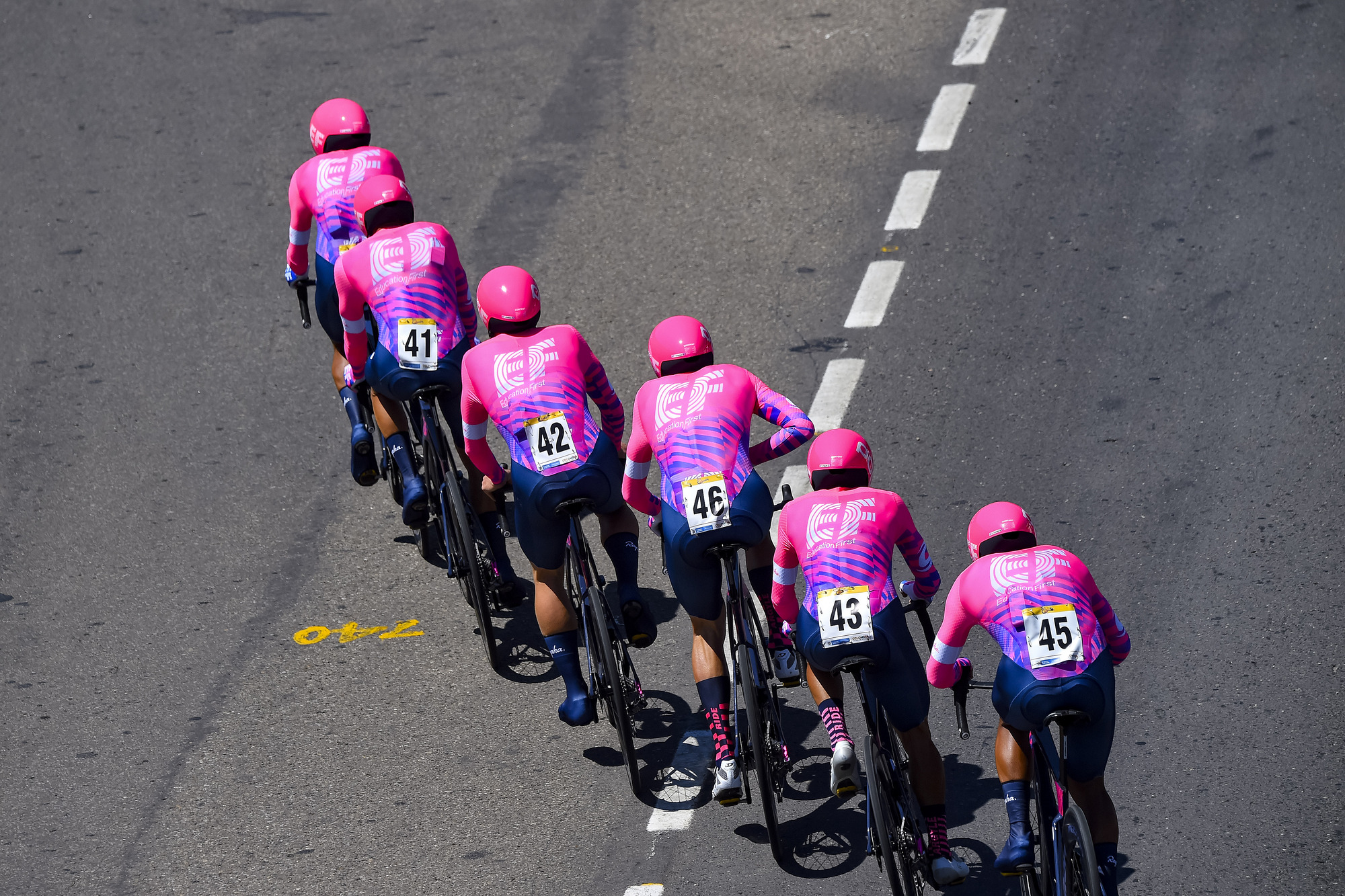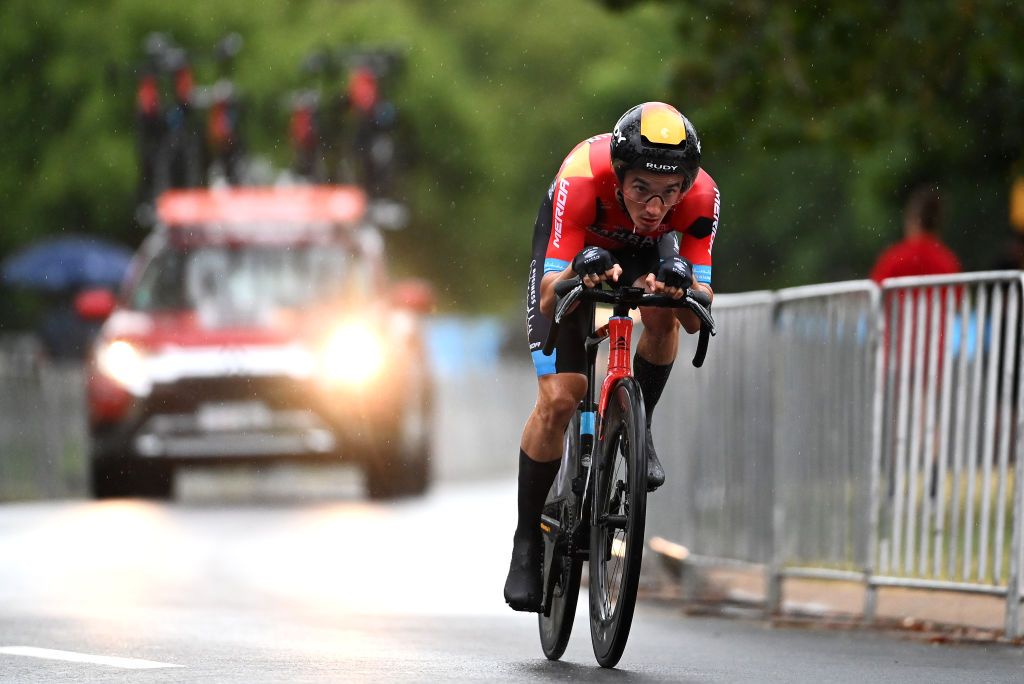Every second counts in UAE Tour team time trial - Preview
Tom Southam reveals the secrets of a successful TTT

“After today’s team time trial, tomorrow we have another one,” was Pello Bilbao’s wry comment after he and 12 other echelon breakaway riders had laid down the law in Monday’s opening stage of the UAE Tour.
But if the stage 1 move was a spur-of-the-moment attack, Tuesday’s TTT has been on the cards since the route publication weeks beforehand, giving teams ample time to prepare for it and meditate its consequences.
For Soudal-QuickStep and UAE Team Emirates Tuesday’s 17.2 kilometre TTT at the Al Khalifa Port is a vital part of the battle for overall victory.
However the comparative rarity of team time trials in WorldTour racing and its undoubted potential for both high drama and for a squad to shine as a unit make them a red-letter day in most teams schedules.
Often mentioned as a source of dread by riders, that’s not always the case, with Luke Plapp (Ineos Grenadiers) describing it as “the best event in cycling.”
EF Education-EasyPost directeur sportif Tom Southam told Cyclingnews: “I think some people like them, because the more work you put in, the faster and easier you get results.”
“They used to be seen as low-hanging fruit, because a lot of other people used to have that kind of negative attitude towards them, but these days all the teams are much more professional.”
The latest race content, interviews, features, reviews and expert buying guides, direct to your inbox!
“You do get the rewards with them, because the guys know that they can do something. It’s a nice thing to do in that respect, they know the work you put in is what you get out. Plus the team’s sports scientists love them: they get a lot out of it, as well.”
Southam is no fan of team time trials in week-long stage races like the UAE Tour.
“In three-week races they are fine, but personally I think TTTs can kill a race if it’s a short one, because you can get too many riders from a single team ahead on GC.”
A definitive verdict on the TTT at this year's UAE Tour will only emerge on Sunday night after the ascent of Jabal Hafeet.
Southam sees today’s TTT as “the most important part of the race, because the climbs aren’t amazingly hard and Jabal Jais in particular is all about drafting.”
The key to team time trial success, he said, is both simple and tricky.
“Practice: you work out the orders, who sits well behind who, look at the drafting, who takes the longest turns, who takes the shortest turns to survive, where they can survive until on the course. We’ve also looked at doing U-turns because there are two in this course, how you go in and come out of the corner, placing and so on.”
Plan B's and disaster scenarios
Times are taken on the fourth rider across the line of the seven-rider teams, although Southam emphasises that keeping an even, paced effort that the team can handle is vital.
“It’s hard for everyone, but that’s what we look into. We’re thinking ‘this guy can do a 20-second turn and get back on, the next guy might have to do 10 seconds or 15 seconds otherwise he might not. And that’s one thing we try to avoid: somebody going over the top and going too hard, coming out and then just not coming back into the line again.”
In their history as a team of well over a decade, the American squad have had some notable successes in team time trials, including the opening TTT of the Giro d’Italia in 2008, and then some notable disasters, such as in the same race on a windy, rain-lashed night in Belfast in 2014 when team leader Dan Martin crashed.
As Southam points out, it’s crucial both to think on your feet and plan ahead for what can be a very unpredictable event, with punctures or mistimings of a rider’s effort wrecking team plans in a blink of an eye.
“You have to go through all the Plan Bs, run through all the scenarios that can happen based on every single rider,” Southam says. “Because you’ve got your team leader, a plan B, possibly a third rider…”
“But it’s actually fine to do that work, because it has its rewards, and hopefully you will never have to use the disaster scenarios. But you’ve got to do it.”
For the 2023 UAE Tour, EF Education-EasyPost have some competent TTers to fall back, with Southam mentioning new signing Andrey Amador and Poland’s Łukasz Wiśniowski, as well as the “young guys who’ve performed pretty well in training camps. There are no super-standouts for this, but it’s a good quality squad.”
The logistics of doing a TTT, or indeed any TT, in a non-European event are not so simple.
“Getting all the bikes here, in a race like this that you have to fly to, it’s a lot of excess luggage,” Southam points out.
“Plus you don’t have the set-up you’d normally have at a time trial, team buses and so on, so here everything has to happen seven times.”
“I’m not so not sure how many teams even have spare team time trial bikes here, so imagine if something happens to somebody’s bike, you’ve got a potential scenario where people are riding on road bikes in a TTT. Working your way around things like that, and making sure you’ve got all the right bits in the right place is probably the hardest thing of the whole stage.

The alternative solutions to get round the logistics are not so obvious, either.
“We could have a team time trial specifying it’s only with road bikes, but these days everyone would probably get a specialist road bike set up with narrower handlebars, anyway,” Southam suggests.
“There’s more planning and working, but on the day everyone’s gone in one go," Southam says comparing team time trials with individual time trials.
"Individual time trials are a nightmare: everybody’s got a different schedule, everybody wants to eat at a slightly different time, and because of the classification changes, you can’t make that schedule up until the night before. A team time trial, everybody goes and finishes at the same time, so at least that part is straightforward.”
The mood in the following team car is already intense in a usual TT, but in a TTT, with seven riders to watch, Southam says the sports director’s degree of concentration is that much higher, but thankfully, given the distances, normally a lot shorter.
“When you’re in the car in any TT you’re saying ‘on this bend, go hard here, ease back here,’ and got to do all of that”; Southam recounts.
“Plus you constantly have to make sure people aren’t doing the wrong length of turn, make sure they swing off right, make sure they have taken enough time out before coming back in, that they’ve got their hands down right on the bars in the right place."
"It’s much more involved, but as an actual time frame, it’s quite short. Plus as I said, it’s nice to knock it out in one go.”
Alasdair Fotheringham has been reporting on cycling since 1991. He has covered every Tour de France since 1992 bar one, as well as numerous other bike races of all shapes and sizes, ranging from the Olympic Games in 2008 to the now sadly defunct Subida a Urkiola hill climb in Spain. As well as working for Cyclingnews, he has also written for The Independent, The Guardian, ProCycling, The Express and Reuters.
